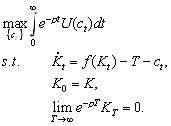John Hassler
Kjetil Storesletten
Åsa Johansson
March 21, 1997
EXAM
Macroeconomics I
5 points
As usual the exam consists of three parts, I Short Questions,
II Problem and III Essay. Choose 5 questions from part I, one
from part II and one from part III. A pass will require 60 points
(out of 100) and a pass with distinction 80 points. Make sure you
spend your time wisely. One of us will come down after 90
minutes, it is advisable that you read through the exam before
that.I Short answers
Choose 5 out of the following 6. 1 page per question should be
more than enough for your answers. Worth 10 points each.
- Evaluate the following statement: "A temporarily
high government spending, like a war, should be financed
by temporarily high taxes."
- Evaluate the following statement: "Humans do not
live for ever. The probability of dying implies that the
Ricardian Equivalence theorem cannot hold."
- Is the following statement true, false or uncertain?
"If an individual’s savings behavior is
unaffected by risk one knows he is risk-neutral."
- In a standard Solow model, let Y=Ka N1-a with
a =0.5. Let population growth
rate be 0.02, the savings rate = 0.10 and depreciation
0.10. Compute the steady state consumption per capita.
- The standard Ramsey model predicts convergence;
production and consumption growth is higher in countries
with low initial capital stocks. What would happen with
that prediction if we considered a small open economy,
with free flows of capital?
- Is the following statement true, false or uncertain? If
the agent’s subjective discount rate is positive,
then the steady state capital stock in a Ramsey model is
always lower than the Golden Rule capital stock.
II Problem
Do one of the following two problems (choose 8 or 9). Provide
a strict formal argument. Worth 25 points
7. Taxation in the Ramsey model
Consider n representative individual who solves
 1
1
where U is a CARA type utility function, f is a
standard concave production function, K is the capital
stock, c is consumption and T is a tax.
- Set up the current value Hamiltonian with its necessary
conditions for optimality.
- Express the optimality conditions and the transition
equation for K as a system of two differential
equations in K and c. (Hint; Take time
derivatives of the condition for the maximum of the
Hamiltonian). Present your results as a phase diagram in K
and C. Make sure you indicate movements in the
phase diagram in all areas and any potential saddle path.
- What are the effects of an unexpected permanent increase
in the tax rate. Indicate transitions and the long run
effect in the phase diagram. Describe in words what is
happening and provide intuitive economic explanations.
- Now consider an unexpected temporary increase in the tax
rate, between, say, time t and T. Indicate
transitions and the long run effect in the phase diagram.
Describe in words what is happening and provide intuitive
economic explanations.
- Lastly, assume that at t it is announced that at T
the tax rate will permanently be raised at T
>t. Describe in words what is happening and
provide intuitive economic explanations.
8. Intertemporal substitution of labor
Assume that
- The agents have preferences over leisure lt and consumption ct and maximize
 where u(.)
is concave and increasing.
where u(.)
is concave and increasing.
- Markets are complete.
- Labor input is indivisible, i.e. one can work h0 hours or not at all (so leisure is 1-
h0 or 1, say).
- Show that aggregation holds in this economy in the sense
that, by introducing a particular set of assets
(lotteries), the aggregate outcomes could have been
generated by a representative consumer (with preferences
not necessarily the same as those of the underlying
agents, see (b) below).
- Show that the preferences of the representative agent are
linear in aggregate labor input, regardless of the
concavity of u(.).
- What does the findings in (b) teach us about the
willingness to substitute leisure across time for the
representative agent versus the individuals in the
economy? Explain why this can to some extent resolve the
criticism levied against RBC theory.
III Essay
Choose 1 out of the following 2. Emphasize discussion rather
than formalism. Worth 25 points.
9. Asset Pricing Models
The standard and consumption based CAPM are two variants of
assets pricing models? How do they differ in their assumptions
and implications? Describe some empirical tests of the two models
and discuss their relative performance. Provide some hypothetical
explanations for the empirical findings.
10. Real Business Cycle Models
Discuss the criticisms against Real Business Cycle models as a
theory for real-world fluctuations. Assess how reasonable the
assumptions underlying the theory is and indicate why or why not
a theory that relies on so strong assumptions can be useful.
Emphasize what type of questions the simple versions of RBC
theory we have seen in class can and cannot be used to address.
Good Luck!
 1
1 1
1